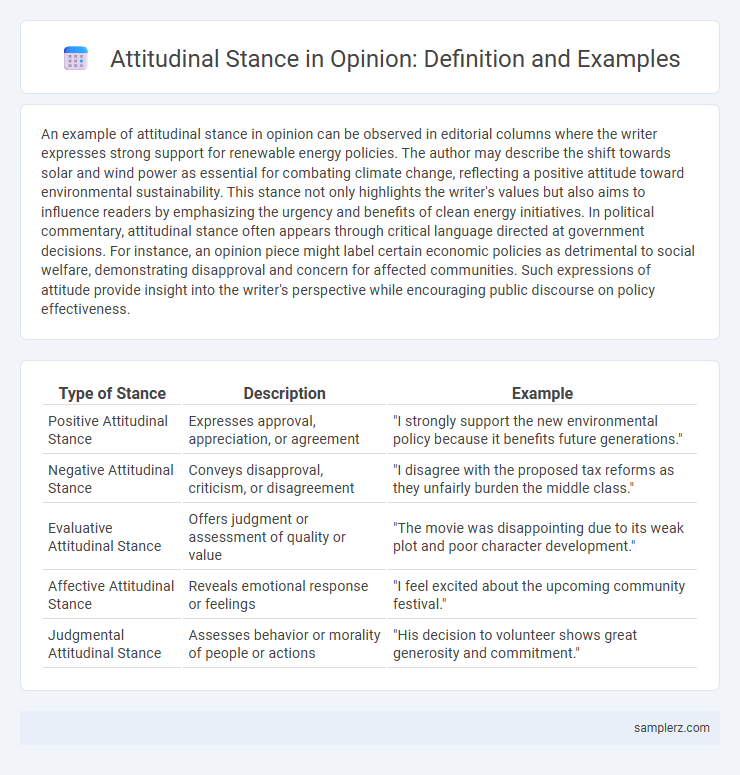An example of attitudinal stance in opinion can be observed in editorial columns where the writer expresses strong support for renewable energy policies. The author may describe the shift towards solar and wind power as essential for combating climate change, reflecting a positive attitude toward environmental sustainability. This stance not only highlights the writer's values but also aims to influence readers by emphasizing the urgency and benefits of clean energy initiatives. In political commentary, attitudinal stance often appears through critical language directed at government decisions. For instance, an opinion piece might label certain economic policies as detrimental to social welfare, demonstrating disapproval and concern for affected communities. Such expressions of attitude provide insight into the writer's perspective while encouraging public discourse on policy effectiveness.
Table of Comparison
| Type of Stance | Description | Example |
|---|---|---|
| Positive Attitudinal Stance | Expresses approval, appreciation, or agreement | "I strongly support the new environmental policy because it benefits future generations." |
| Negative Attitudinal Stance | Conveys disapproval, criticism, or disagreement | "I disagree with the proposed tax reforms as they unfairly burden the middle class." |
| Evaluative Attitudinal Stance | Offers judgment or assessment of quality or value | "The movie was disappointing due to its weak plot and poor character development." |
| Affective Attitudinal Stance | Reveals emotional response or feelings | "I feel excited about the upcoming community festival." |
| Judgmental Attitudinal Stance | Assesses behavior or morality of people or actions | "His decision to volunteer shows great generosity and commitment." |
Defining Attitudinal Stance in Opinion Pieces
Attitudinal stance in opinion pieces reflects the writer's emotions, judgments, and evaluations toward the subject, shaping readers' perceptions through tone and word choice. This stance is often conveyed through modal verbs, adjectives, and adverbs that signal certainty, doubt, or intensity, effectively guiding the audience's response. Recognizing attitudinal stance is crucial for understanding bias, persuasion techniques, and the underlying values within opinion writing.
Common Forms of Attitudinal Stance
Common forms of attitudinal stance in opinion pieces include expressions of approval, disapproval, certainty, and uncertainty, which reveal the writer's emotional engagement and evaluative position. Positive appraisal may be conveyed through words showing admiration or satisfaction, while negative appraisal often involves criticism or disappointment. Expressions of certainty strengthen arguments by indicating confidence, whereas hedging signals doubt or openness to alternative perspectives.
Positive Versus Negative Stance Examples
Expressing a positive attitudinal stance in an opinion often involves highlighting benefits, achievements, or favorable outcomes, such as praising a new policy for improving community well-being. In contrast, a negative stance emphasizes drawbacks, failures, or concerns, like criticizing a government decision for causing economic instability. These contrasting tones shape the reader's perception by either endorsing or challenging the subject's value and impact.
Evaluative Language in Opinion Writing
Evaluative language in opinion writing reveals the writer's attitudinal stance by expressing judgments about people, events, or ideas. Words such as "outstanding," "disappointing," or "problematic" indicate positive or negative evaluations, shaping readers' perceptions and emotional responses. This strategic use of evaluative language strengthens the argument by clearly signaling the writer's approval or disapproval.
Expressing Judgement Through Attitudinal Stance
Expressing judgement through attitudinal stance in opinion writing involves evaluating actions, events, or characters using positive or negative language to convey approval or disapproval. This approach often employs evaluative adjectives, adverbs, and modal verbs to reflect attitudes and shape readers' perceptions. Judgement in opinions can express trustworthiness, admiration, criticism, or condemnation, enhancing the subjective tone and influencing audience response.
Impact of Stance on Reader Perception
Expressing a strong attitudinal stance in opinion pieces shapes reader perception by clearly signaling the writer's values and emotions, which enhances engagement and relatability. Positive or negative evaluations guide readers toward a particular interpretation, reinforcing or challenging their preexisting beliefs. This strategic use of stance influences the persuasive power of the text by creating emotional resonance and credibility.
Subtle Versus Explicit Attitudinal Stances
Subtle attitudinal stances often rely on nuanced language, such as irony or understatement, to convey opinions indirectly, allowing readers to infer the stance through context. Explicit attitudinal stances utilize clear, direct expressions of judgment or emotion, leaving little ambiguity about the author's viewpoint. The choice between subtle and explicit stances can influence the tone and persuasiveness of opinion texts, shaping reader engagement and interpretation.
Cultural Influence on Attitudinal Expression
Attitudinal stance in opinion often reflects deep-rooted cultural influences shaping how individuals express approval or disapproval. For instance, Eastern cultures might emphasize indirectness and harmony in attitude expression, contrasting with the directness and assertiveness typical in Western discourse. This cultural context profoundly affects the tone, intensity, and formality of attitudinal language used in opinions.
Techniques for Balancing Objectivity and Stance
Effective techniques for balancing objectivity and attitudinal stance in opinion writing include the use of hedging language, which softens claims and acknowledges alternative perspectives, enhancing credibility. Incorporating evidence-based reasoning paired with personal judgment demonstrates informed opinions while maintaining analytical rigor. Employing modal verbs like "might" or "could" allows authors to present opinions tentatively, preserving openness and reducing bias.
Enhancing Persuasion with Attitudinal Cues
Attitudinal stance in opinion writing enhances persuasion by expressing clear evaluations that resonate emotionally with the audience, such as positive adjectives like "innovative" or negative terms like "ineffective." Utilizing modal verbs like "must" or "should" conveys certainty and urgency, reinforcing the writer's commitment to their viewpoint. Strategic use of attitudinal cues shapes readers' perceptions and strengthens the overall argumentative impact.

example of attitudinal stance in opinion Infographic
 samplerz.com
samplerz.com